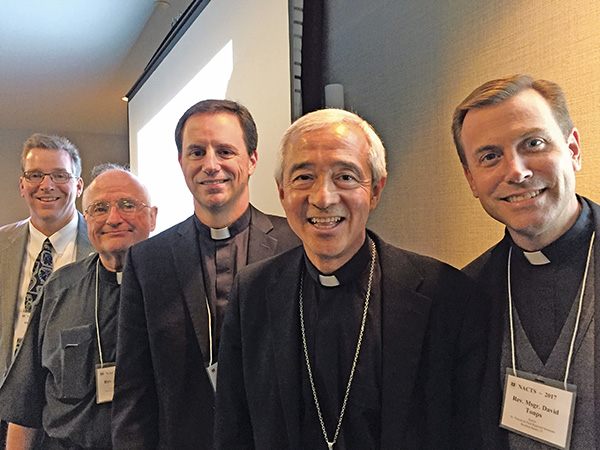UPDATE: The online version of this article has been updated to include new information regarding the "pastoral stage" of ministry preparation.
In late September, more than 80 Roman Catholic priests, bishops, and lay leaders met in Chicago at a gathering hosted by the National Association of Catholic Theological Schools (NACTS). Their purpose: to consider the implications of new guidelines for seminary formation recently issued by the Congregation for the Clergy, the Vatican office charged with overseeing priests, deacons, and theological education.
The new Ratio Fundamentalis Institutionis Sacerdotalis, published in English as “The Gift of the Priestly Vocation,” builds on earlier guidelines issued by the Vatican in 1970 and 1985. The product of worldwide consultation, the new document reframes the human, spiritual, intellectual, and pastoral dimensions of seminary formation — the “four pillars” of formation that were promulgated in Pope St. John Paul II’s 1992 Apostolic Exhortation, Pastores Dabo Vobis (published in English as “I Will Give You Shepherds”).
For 25 years, these four pillars have structured education and assessment at Roman Catholic seminaries. Non-Catholic schools interested in spiritual formation have also taken note of them. According to Cardinal Beniamino Stella, prefect of the Congregation for the Clergy, the inspiration for this update and renewal of priestly formation derives from Pope Francis’s own spirituality and his warnings against the temptations of money, authoritarianism, legalism, and vainglory in the priesthood.
The Roman Catholic Church approaches theological education as an issue for the international church, and efforts at reform flow from the Vatican outward, leaving considerable latitude for national conferences of bishops to adapt the universal guidelines for local institutions. Individual seminaries work within the guidelines established by their national conference of bishops. At the two-day gathering of American seminary leaders held in September, three levels of the Roman Catholic Church were represented — an official from the Vatican, representatives from the United States Conference of Catholic Bishops (USCCB), and members of NACTS.
Mexican Archbishop Jorge Carlos Patrón Wong, secretary for seminaries within the Congregation for the Clergy, described the vision of the new Ratio on the first day of the meeting. On the last day, Bishop Earl Boyea of Lansing, Michigan, chair of the USCCB’s Committee on Clergy, Consecrated Life, and Vocations, led a private session for seminary heads on the implications of the new guidelines for the next revision of the Program of Priestly Formation (PPF). The PPF is the American document that applies big-picture Vatican principles to the American context. The most recent edition of the PPF, the fifth, was issued in 2005. A sixth edition is not expected to appear for at least two more years, after Vatican approval. (The Canadian Conference of Catholic Bishops has its own separate Program for Priestly Formation, last revised in 2002.)
 |
|
Archbishop Jorge Carlos Patrón Wong with members of the NACTS executive committee. From left, Christopher J. McAtee, Father John G. Lodge, Msgr. Todd J. Lajiness, Archbishop Patrón Wong, and Msgr. David L. Toups. Not pictured: Msgr. Peter I. Vaccari and Father Michael Patella.
Credit: Christa Klein
|
Key features of the new Ratio, which may be incorporated into the next edition of the PPF, reflect Pope Francis’s desire for a personalized course of gradual instruction that includes an additional “propaedeutic [introductory] stage”— a year or two in which a candidate shows evidence of his vocation to the priesthood by learning to live “a Christian, chaste, and generous life.” In the United States, this stage would extend the already-lengthy course of formation now in place: typically two years of pre-theology (mandated for entering seminarians who have a bachelor’s degree but insufficient background in theology and philosophy), then three to four years of graduate-level theological studies, and as required by some dioceses, a “pastoral year” in a diocesan parish between the third and fourth year.
In the new Ratio, the seminarian is seen as a spiritual apprentice. The newly-proposed “propaedeutic” period is also called the “discipleship stage” and ideally takes place outside of the seminary. The two years of pre- theology (if required) and the three years of theological studies are the “configuration stage,” emphasizing that these years of education should be personalized for each student.
Finally, while seminaries themselves employ a variety of approaches to incorporate shorter periods of supervised residential pastoral training, a notable part of all previous editions of the U.S. PPF, the newly mandatory intensive period of parish-centered formation after seminary as the “pastoral stage” may further lengthen formation while altering seminary formation. Both formal and informal conversations in September featured these issues.
In question-and-answer sessions, Archbishop Patrón Wong also emphasized the feature of “human accompaniment,” to be modeled during all three stages. The seminary rector is expected to serve as pastor of the “seminary parish” and ensure individualized spiritual direction for each seminarian — a practice that each person, once ordained, is to carry into his own pastorate. The intent is to shape emotionally mature priests who have learned the arduous discipline of living in faith, hope, and love — pastors who can, with “discernment” (as understood in Jesuit spirituality), understand and guide their flocks with Christ’s profound love and mercy.
Topics addressed at this year’s NACTS gathering will likely continue to dominate its agenda and challenge the bishops’ conference in the U.S. (and Canada) as it approves a new edition of the PPF. Only three years old, NACTS replaces gatherings formerly hosted by regional organizations of Roman Catholic seminaries as well as the now-disbanded Seminary Department of the National Catholic Educational Association.
Online documents